<<PREVIOUS -
HOME -
CONTENTS -
NEXT>>
ASTROIMAGING - ITS
![]()
Imaging The Sky 2001 Conference
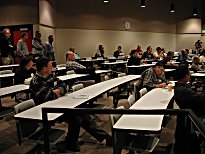
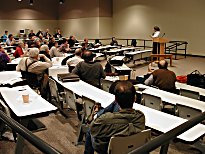
<<PREVIOUS -
HOME -
CONTENTS -
NEXT>>
ASTROIMAGING - ITS
![]()


The successful record breaking Imaging The Sky 2001 Conference was held on November 2 – 3, 2001 in Salem, Oregon, USA. This year the conference had record-breaking attendance of 88 attendees from Portugal, Ontario Canada, Alaska, Washington, Oregon, California, Arizona, New Hampshire, Texas and other states. Mel Bartels, Richard Berry, Jim Girard, David Haworth, Rick Kang and Nick Liepins organized the conference. Imaging The Sky 2001 Conference schedule PDF file 16 KB.
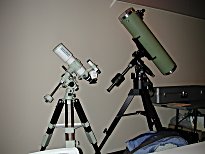
In the conference room Hardin Optical showed the new Televu NP101 refractor, a Takahashi 90mm apochromat refractor and a reflector telescope on a G-8 mount. Also, they donated a $995.00 10" mirror set for a door prize.
At times, the conference was split into two tracks. Track 1 was intended for newcomers to CCD imaging and track 2 was geared toward intermediate/advanced imagers. By having two tracks of sessions it provided more talks on amateur astronomy CCD imaging and applications than the previous Imaging The Sky conferences.
The conference provided excellent opportunity to discussion CCD imaging techniques with experts from around the world.
Dave Kenyon, Sierra College Professor, presented CCD Imaging Methods and Techniques. Dave gave an overview of CCD imaging applications that included, supernova hunting, astrometrics, stellar photometry, asteroid photometry, comet photometry, spectroscopy and observing by imaging. Dave covered the basics of CCD operation that included CCDs advantages, CCDs limitations and how CCDs are specified. Dave gave an overview of what is needed for CCD imaging. This included matching the telescope to the CCD, telescope mounts configurations, mount tracking errors, telescope balancing, polar alignment, focusing masks aids, and other CCD operating concepts. The end of the session covered CCD operation that included camera setup, focusing, acquiring the object and other operational aspects of CCD imaging.
Ron Wodaski, author of The New CCD Astronomy, presented Essential Characteristics of a Well Crafted Image. His session covered importance of telescope mounts, focusing techniques, color processing techniques and selective image processing such as blur the areas with noise and sharpening the areas with good S/N.
Richard Berry, author of The CCD Camera Cookbook book, Choosing and Using a CCD Camera book, The Handbook of Astronomical Imaging Processing book and other books, presented Non-Linear Image Processing. Using AIP4WIN Richard demonstrated rank image processing and details it reveals in comets. Also, covered were the differences in average combine and median combine. Examples of local adaptive sharpening on a moon image was demonstrated.
Jim Girard moderated a series of presenters on their Observatories for CCD Imaging.
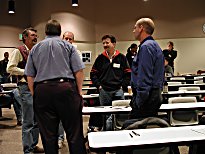
Antonio Cidadão presented High Resolution Planetary Imaging. Antonio likes planetary imaging because of the changing details that can occur in a few days, hours and sometimes minutes. Antonio showed different details of Jupiter using different filters. The second part of the session covered the need for high resolution imaging for the planets. He showed how atmosphere-limited planetary imaging can be mastered and may be routinely performed. The most important factor is the atmosphere. He shared his experiences with adaptive optics, image integration times, and APO telescope versus SCT telescope versus telescope aperture versus atmosphere turbulence. His ideal planetary CCD camera is the SBIG ST-5C. Antonio coverd image sampling regarding planetary imaging. His imaging processing includes a 2x enlargement step to give a super-resolution effect. Also, covered were tips on cosmetic corrections, 3-D anaglyphs and movies.
Doug George, head of Diffraction Limited , presented Integrated Imaging Solutions. CCD imaging is a complex task and the goal is to make CCD imaging easier and accessible to more amateur astronomers. Manual operation and problems waste rare clear, dark skies and results in fewer images and more frustrations. Software can turn CCD imaging equipment into an integrated observing system. A key capability is ASCOM, which is an astronomy common object model that allows different software products to be integrated into an observing system. Three case studies were presented. Case study one was a portable images setup using a Meade 8” LX200 with a Technical Innovations RoboFocus, Optec IFW motorized filter wheel, and Apogee AP7p CCD camera. Case study two included the Puckett Observatory Supernova Search using a 24” Ritchey-Chretien. The third case was the SMARTScope, which is a complete robotic observatory being built using off-he-shelf hardware.
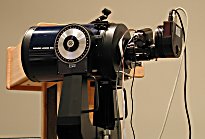
Larry Weber’s and Steve Brady’s presentation on Fast Auto-Focus Method and Software for CCD-based Telescopes was of high interest to everyone. Larry and Steve created a new focus metric called half flux diameter. It can quantitatively measure a wide range of out-of-focus star shapes, One can fully characterize a telescope system using the half flux diameter measurement technique and V curve measurements. At the end of the session they demonstrated fast auto-focus using their FocusMax software on a LX200.
Late Friday evening the following show and tell presentations were presented.
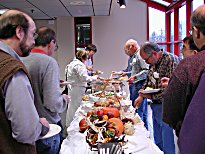
Saturday morning started off with coffee, juice and donuts. Session breaks provided time to further explore CCD imaging techniques with the presenters and other attendees. Saturday morning coffee, juice, donuts and noon lunch was included in the conference registration fee.
Tom Carrico who is part of the ARGO group presented Planning an Imaging Session. Tom presentation included setting up equipment, selecting objects to image and imaging effectively. Tom’s experiences indicate that telescope mount balance is more important than people think. His advice is to take care of lose cables. Tom’s typical plan is to image 1 to 3 objects in a good night. You need to pick objects that you can image with your equipment. Tom uses NGCView, DeepSky2000, TheSky, Vickers CCD Atlas and the STScI Digitized Sky Survey to help him plan an evening imaging session. At the end Tom demonstrated how he planned an imaging session.
Dale Mais presented a session on Spectroscopy using the SBIG Self-Guided Spectrometer (SGS). Dale explained how the SGS operated with two different resolutions and showed how to analyze data from it. Dale provided an overview of spectroscopy and showed examples of detecting rare technetium and how the spectrum of a star changes.
Roy Tucker presented his work on three special telescopes that work together to drift image long narrow segments of the sky. Roy’s system is designed to discover asteroids and other moving objects. Roy shared his unique telescope design that eliminates temperature effects on focusing and how he built the three CCD cameras for the telescopes.
Steve Mandel presented Imaging Down Under, and Up Above, which was on his imaging experiences in Australia. Also, Steve presented his techniques on imaging using a SBIG ST10 CCD camera with various Nikon camera lens with an H alpha filter. Steve showed how he modified the SBIG color wheel to mount Nikon camera lens directly on it.
Richard Berry and James Burnell authors of The Handbook of Astronomical Imaging Processing book presented Introduction to Image Processing Demo. The presentation was a series of demonstrations of image processing techniques using AIP4WIN. The image processing techniques included calibration, photometry, brightness, unsharp masking and correct color processing.
Tom Krajci presented Photometry. Tom Krajci gave a fact filled presentation on photometry. Using a Cookbook CCD and homemade mount, Tom collects photometric data for the CBA accurate to 0.006 magnitude. The thorough presentation Tom gave explanations and how-to's sufficient for audience members to go home and begin photometric observations. Tom discussed characterizing equipment for photometry, the procedure to obtain photometric data, and what to do with your data.
Antonio Cidadão presented Getting Started Quickly with a QuickCam. Antonio discussed the advantages and limitations of using webcams for astroimaging. He has obtained impressive results imaging the planets and moon. Antonio reviewed the three webcams that are suitable for astroimaging and how to modify them for use on a telescope. Software for controlling webcams includes Astro-snap with its many features to simply astroimaging. Antonio showed how to correct webcam image problems in Adobe Photoshop,
Richard Berry gave an update on the ISSAT. The ISSAT is the International Space Station Amateur Telescope project. The telescope will be delivered to the Space Station on an ISS Express Pallet and mounted on the ISS truss.
The conference ended with a group dinner and discussions that continued on late into the night.
At time there were two sessions going on at the same time. I do not have summaries for the following sessions that I did not attend:
Mel Bartels created an Image the Sky 2001 CD-ROM that was given to each conference attendee. The CD-ROM included the following information:
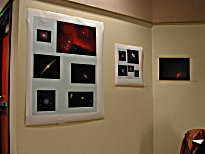
|
ARGO Images |
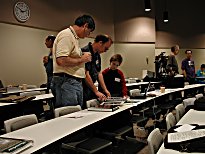
|
Sharing Images |
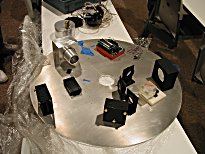
|
Adaptive Optics Project |

|
Conference Location |